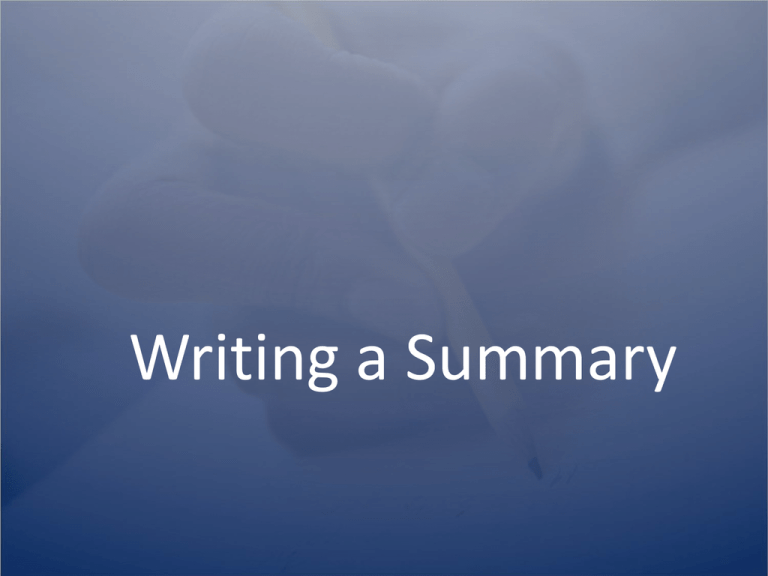Writing a Summary
advertisement

Writing a Summary Definition of a Summary • “A summary is a condensed version of a larger reading. A summary is not a rewrite of the original piece . . . To write a summary, use your own words to express briefly the main idea and relevant details of the piece you have read. Your purpose in writing the summary is to give the basic ideas of the original reading” (http://homepage.smc.edu/reading_lab/writi ng_a_summary.htm). Selecting a Source • When choosing an article to summarize, keep in mind that your summary will be approximately 25 percent of the length of the original article. This will allow you to cover all the major points. For example, if your assignment is to write a 500-word summary, choose an article that is approximately 2,000 in length. Selecting a Source, Continued • Consider the readability of the article. There will be some unfamiliar terms in any article, but if an article is written for experts in a particular field, it will be too difficult for a layperson to understand, and therefore, impossible to summarize. • Check to ensure that the publication is up-to-date by looking at the date of publication, and also make sure that the author is an expert in his or her field. Reading the Source • Read through your source, taking note of main and major ideas. Main ideas usually appear at the beginning of the article and may reappear at the end as well. Major ideas usually appear that the beginning of a paragraph and are followed by supporting details. • Next, look for major details and examples that support main and major ideas. Reading the Source, Continued • Record information needed for your Works Cited list. • For a traditional print article, record the name of the author, the title of the article, the date of publication, the volume and issue number, and the page numbers. • For an online article, also record the date you accessed the article, the url (web address), and the name of the database along with the suscribing library, if applicable. First Draft • Similar to any other essay, the structure of your summary should include an introductory paragraph. This introduction, however, should include the name of the article’s author, the title of the article, and the central idea or thesis of the article. • The body paragraphs should address the most important points in the original article. The topic sentence of each paragraph should state the main idea of that paragraph and include the name of the article’s author. First Draft, Continued • Do not insert your own ideas or opinions. Remember that you are restating the original author’s ideas in your own words and in a condensed form. • The concluding paragraph should sum up the author’s ideas. Finalizing Your Summary • Proofread and correct your rough draft carefully. • Make sure your summary has not left out anything important, that it makes the same point as the original article, and that it is coherent and flows smoothly. Finalizing Your Summary, Continued • Have a tutor or peer review your summary critically. Ensure that your reader can understand the purpose of the original article from reading your summary. • Correct all mechanical errors. • Document your source in a Works Cited page. Sources • Arlov, Pamela. Wordsmith: A Guide to Paragraphs and Short Essays. 4th ed. Upper Saddle River, NJ: Pearson, 2010. Gorrell, Donna. The Purposeful Writer: A Rhetoric with Readings, 2nd ed. Boston: Allyn and Bacon, 1993. Adapted by Judith Kilborn with the author's permission for The Write Place, St. Cloud State University. “Process for Writing a Summary.” 1997. 13/9/10. http://leo.stcloudstate.edu/acadwrite/ summary.html. Writing a Summary. 13/9/10. http://homepage. smc.edu/reading_lab/writing_a_summary.htm).











